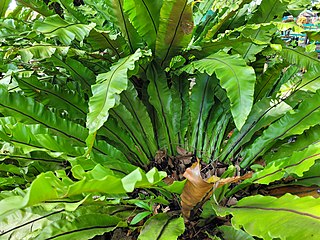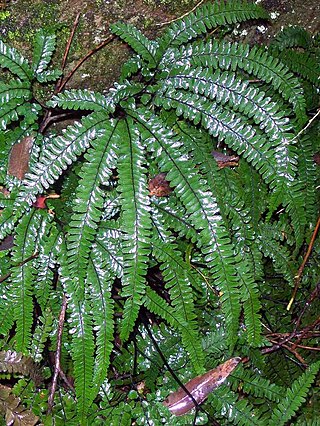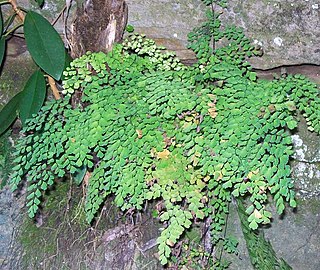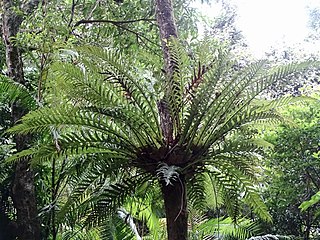
Marattiaceae is the only family of extant (living) ferns in the order Marattiales. In the Pteridophyte Phylogeny Group classification of 2016, Marattiales is the only order in the subclass Marattiidae. The family has six genera and about 110 species. Many are different in appearance from other ferns, having large fronds and fleshy rootstocks.

Platycerium is a genus of about 18 fern species in the polypod family, Polypodiaceae. Ferns in this genus are widely known as staghorn or elkhorn ferns due to their uniquely shaped fronds. This genus is epiphytic and is native to tropical and temperate areas of South America, Africa, Southeast Asia, Australia, and New Guinea.

Asplenium nidus is an epiphytic species of fern in the family Aspleniaceae, native to tropical southeastern Asia, eastern Australia, Hawaii, Polynesia, Christmas Island, India, and eastern Africa. It is known by the common names bird's-nest fern or simply nest fern.

Polypodiaceae is a family of ferns. In the Pteridophyte Phylogeny Group classification of 2016, the family includes around 65 genera and an estimated 1,650 species and is placed in the order Polypodiales, suborder Polypodiineae. A broader circumscription has also been used, in which the family includes other families kept separate in PPG I. Nearly all species are epiphytes, but some are terrestrial.

Osmunda regalis, or royal fern, is a species of deciduous fern, native to Europe, Africa and Asia, growing in woodland bogs and on the banks of streams. The species is sometimes known as flowering fern due to the appearance of its fertile fronds.
Alsophila approximata, synonym Cyathea approximata, is a species of tree fern endemic to Madagascar.

Aglaomorpha fortunei, commonly known as gu-sui-bu, is a species of basket fern of the family Polypodiaceae. The plant is native to Eastern Asia, including eastern China.

Pteris tremula, commonly known as Australian brake, tender brake, tender brakefern, shaking brake is a fern species of the family Pteridaceae native to sheltered areas and forests in eastern Australia and New Zealand. It has pale green, lacy fronds of up to 2 meters in length, with an erect, tufted rhizome that is covered with narrow brown scales. It is fast-growing and easy to grow in cultivation, but can become weedy.

Gleichenia dicarpa, commonly known as pouched coral fern or tangle fern, is a small fern of the family Gleicheniaceae found in eastern Australia, New Caledonia and New Zealand. It forms tangled thickets in wet places such as swamps and riverbanks.

Angiopteris evecta, commonly known as the king fern, giant fern, elephant fern, oriental vessel fern, Madagascar tree fern, or mule's Foot fern, is a very large rainforest fern in the family Marattiaceae native to most parts of Southeast Asia and Oceania. It has a history dating back about 300 million years, and is believed to have the longest fronds of any fern in the world.

Adiantum hispidulum, commonly known as rough maidenhair fern or five-fingered jack, is a small fern in the family Pteridaceae of widespread distribution. It is found in Africa, Australia, Polynesia, Malesia, New Zealand and other Pacific Islands. Its fronds rise in clumps from rhizomes among rocks or in the soil in sheltered areas.

Adiantum aethiopicum, also known as the common maidenhair fern, is a small fern of widespread distribution, occurring in Africa, Australia, Norfolk Island and New Zealand.

Aglaomorpha is a genus of ferns in the subfamily Drynarioideae of the family Polypodiaceae. The Pteridophyte Phylogeny Group classification of 2016 uses this genus name, while other sources use Drynaria to include Aglaomorpha. Species are commonly known as basket ferns. As circumscribed in PPG I, the genus contains around 50 species.

Dicranopteris (forkedfern) is a genus of tropical ferns of the family Gleicheniaceae. There are about 20 described species.

Drynarioideae is a subfamily of the fern family Polypodiaceae in the Pteridophyte Phylogeny Group classification of 2016 (PPG I). The subfamily is also treated as the tribe Drynarieae within a very broadly defined family Polypodiaceae sensu lato. In either case, it includes the previously separated tribe Selligueeae.

Aglaomorpha quercifolia, commonly known as the oakleaf fern or oakleaf basket fern, is a species of Aglaomorpha in the family Polypodiaceae. Other common names for the fern are pakpak lawin, gurar, koi hin, ashvakatri, kabkab, kabkaban, or uphatkarul.
Primula standleyana, synonym Dodecatheon ellisiae, is a species of flowering plant in the family Primulaceae, native to Arizona, New Mexico and Northeast Mexico. It was first described by Paul Carpenter Standley in 1913 as Dodecatheon ellisiae. When the genus Dodecatheon was reduced to Primula sect. Dodecatheon following molecular phylogenetic studies, the species could not be transferred to Primula as Primula ellisiae, as that name had already been used for a different species. Accordingly, the replacement name Primula standleyana was provided.
Primula utahensis, synonym Dodecatheon utahense, is a species of flowering plant in the family Primulaceae, native to Utah. It was first described by Noel Holmgren in 1994 as Dodecatheon dentatum var. utahense. In 2006, it was raised to a separate species as Dodecatheon utahense. When Dodecatheon was sunk into Primula in 2007, it was transferred to that genus as Primula utahensis.

Aglaomorpha rigidula is a species of tropical fern in genus Aglaomorpha widely distributed throughout Southeast Asia, from Southwest China to Queensland and New South Wales in Australia. Growing as an epiphyte or lithophyte, its green fronds are up to 1.22 metres in length. This fern develops two types of fronds, some of which near the base of the plant are shorter, sterile, and rust-colored which form a basket-like shape that trap moisture and organic components that nourish it. Especially in colder weather, this basket acts as prime habitat for animals such as the Amethystine python.

Aglaomorpha bonii is a species of subtropical fern native to Southeast Asia. Growing as an epiphyte or lithophyte, its rhizome is covered in dry, paper-like fronds while the larger fronds are fertile and bear spores. This fern has long been used in traditional medicine in Vietnam to treat a variety of ailments, and in scientific research, compounds from the plant have demonstrated antibacterial and antioxidant properties.

















